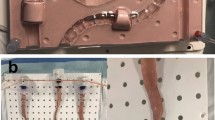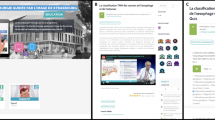Abstract
Background
As flexible endoscopy becomes an increasingly valuable minimally invasive approach to surgical challenges, an efficient and comprehensive training curriculum is needed to train surgeons in therapeutic endoscopy. We developed a modular curriculum utilizing a simulation-based, “into the fire” approach to endoscopic foreign body removal for practicing physicians with task performance pre- and post-testing.
Methods
From 2020 to 2021, two sessions of our advanced flexible endoscopy course were taught by two expert surgical endoscopists using ex-vivo porcine models. The course focused on safe removal techniques for various foreign bodies as part of an overall endoscopy curriculum that uses hands-on simulation-based pre-testing, didactics, and mentored practice sessions, followed by post-course examination. Pre- and post-course assessments and surveys were used to evaluate knowledge, performance, and confidence of participants, and subsequently analyzed using the Wilcoxon-signed rank test.
Results
Of the 16 practicing physicians who participated in the course, 43.8% were certified in Fundamentals of Endoscopic Surgery, and 62.5% had completed > 200 prior upper endoscopies. Upon course completion, scoring on knowledge-based written examinations improved from 3.4 ± 1.9 to 5.8 ± 2.0 (p < 0.001). Technical facility of each participant demonstrated significant overall improvement with post-course score increased from 15.8 ± 2.5 to 23.6 ± 1.6 (p < 0.001), with skill refinement noted in technical subcategories of appropriate instrument use (p < 0.001), foreign body manipulation (p < 0.001), and successful foreign body removal (p < 0.001). Confidence surveys likewise demonstrated significant increase in confidence after completion of the curriculum 11.6 ± 3.4 to 23.0 ± 5.5 (p < 0.001).
Conclusions
The “into the fire” approach to teaching endoscopic foreign body removal utilizing our simulation module provides an effective curriculum to improve knowledge, confidence, and overall technical performance. Our methodology utilizes hands-on, simulation-based pre-testing prior to instruction. This introduces clinical scenarios and technical challenges, while accounting for and tailoring to provider-specific variation in knowledge and experience, facilitating training efficiency.






Similar content being viewed by others
References
Morgenthal CB, Richards WO, Dunkin BJ, Forde KA, Vitale G, Lin E, Flexible Endoscopy Committee SAGES (2007) The role of the surgeon in the evolution of flexible endoscopy. Surg Endosc 21:838–853. https://doi.org/10.1007/s00464-006-9109-4
Franklin BR, Placek SB, Gardner AK, Korndorffer JR, Wagner MD, Pearl JP, Ritter EM (2018) Preparing for the american board of surgery flexible endoscopy curriculum: development of multi-institutional proficiency-based training standards and pilot testing of a simulation-based mastery learning curriculum for the endoscopy training system. Am J Surg 216:167–173. https://doi.org/10.1016/j.amjsurg.2017.09.010
Vassiliou MC, Dunkin BJ, Fried GM, Mellinger JD, Trus T, Kaneva P, Lyons C, Korndorffer JR, Ujiki M, Velanovich V, Kochman ML, Tsuda S, Martinez J, Scott DJ, Korus G, Park A, Marks JM (2014) Fundamentals of endoscopic surgery: creation and validation of the hands-on test. Surg Endosc 28:704–711. https://doi.org/10.1007/s00464-013-3298-4
Nau P, Pauli E, Sandler BJ, Trus T (2020) The SAGES manual of flexible endoscopy. Springer, New York
Vassiliou MC, Kaneva PA, Poulose BK, Dunkin BJ, Marks JM, Sadik R, Sroka G, Anvari M, Thaler K, Adrales GL, Hazey JW, Lightdale JR, Velanovich V, Swanstrom LL, Mellinger JD, Fried GM (2010) Global Assessment of Gastrointestinal Endoscopic Skills (GAGES): a valid measurement tool for technical skills in flexible endoscopy. Surg Endosc 24:1834–1841. https://doi.org/10.1007/s00464-010-0882-8
Kishiki T, Lapin B, Wang C, Jonson B, Patel L, Zapf M, Gitelis M, Cassera MA, Swanström LL, Ujiki MB (2018) Teaching peroral endoscopic myotomy (POEM) to surgeons in practice: an “into the fire” pre/post-test curriculum. Surg Endosc 32:1414–1421. https://doi.org/10.1007/s00464-017-5823-3
Wong HJ, Su B, Attaar M, Kuchta K, Linn JG, Haggerty SP, Denham W, Ujiki MB (2021) Teaching EndoFLIP impedance planimetry to practicing endoscopists: an “into the fire” approach to simulation. Surg Innov. https://doi.org/10.1177/15533506211038088
Wong HJ, Su B, Attaar M, Kuchta K, Linn JG, Denham W, Haggerty SP, Ujiki MB (2021) Teaching peroral endoscopic pyloromyotomy (POP) to practicing endoscopists: an “into-the-fire” approach to simulation. Surgery 169(3):502–507. https://doi.org/10.1016/j.surg.2020.08.023
Wong HJ, Attaar M, Campbell M, Wu H, Kuchta K, Linn JG, Haggerty SP, Denham W, Ujiki MB (2022) A modular simulation curriculum to teach endoscopic stenting to practicing surgeons: an “into the fire” approach. Surg Endosc. https://doi.org/10.1007/s00464-022-09016-0
Funding
None.
Author information
Authors and Affiliations
Corresponding author
Ethics declarations
Disclosures
Drs. VanDruff, Wong, Amundson, Wu, Campbell, Hedberg, Denham, and Kristine Kuchta have no financial interests or conflicts of interest to disclose. Dr Ujiki is a board member of Boston Scientific, and a paid consultant for Olympus and Cook. Dr. Ujiki also receives grant funding from Medtronic [ERP-2020 1228] and receives payment lectures from Medtronic, Erbe, and Gore. Dr. Haggerty is a paid consultant to Medtronic and receives payment for lectures for Gore. Dr. Linn also receives payment lectures for lectures for Gore.
Additional information
Publisher's Note
Springer Nature remains neutral with regard to jurisdictional claims in published maps and institutional affiliations.
This manuscript was accepted for an oral presentation at the Society of American Gastrointestinal and Endoscopic Surgeons (SAGES) 2022 Annual Meeting in Denver Colorado from March 16th to March 19th, 2022.
Rights and permissions
About this article
Cite this article
VanDruff, V.N., Wong, H.J., Amundson, J.R. et al. “Into the fire” approach to teaching endoscopic foreign body removal using a modular simulation curriculum. Surg Endosc 37, 1412–1420 (2023). https://doi.org/10.1007/s00464-022-09382-9
Received:
Accepted:
Published:
Issue Date:
DOI: https://doi.org/10.1007/s00464-022-09382-9




